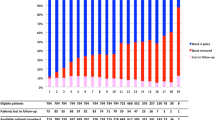Abstract
Background
Swedish adjustable gastric banding (SAGB) is an effective treatment for morbid obesity. The main advantage of this procedure is that this operation is minimally invasive to the stomach and totally reversible and adjustable to the patient’s needs. The aim of this observational study is to present our experience with patients ≤25 years old.
Methods
Between January 1996 and January 2006, 107 patients (85 women, 22 men) of 785 consecutive patients who underwent SAGB during the study period were aged ≤25 years (13.6%). All data (demographic and morphologic data, operative data, and follow-up data) were prospectively collected in a computerized data bank. The postoperative follow-up program was performed most of the time by residents, and 17 different surgeons performed the operation.
Results
The mean total weight loss was 27 kg after 1 year, reaching a total of 40 kg after 8 years. The mean EWL was 65.5% after 8 years, and the BMI decreased from 43.3 to 28.2 kg/m2. In the 107 patients, there were 50 patients with 72 complications (46.7%) and 57 patients with no complication (53.3%). The most common complications were esophagitis (25.2%), pouch dilation (16.8%), port problems (6.5%), esophageal dilation (5.6%) and band leakage (4.7%). Overall, 31 patients (29%) needed a reoperation. There was no mortality.
Conclusion
SAGB operation and the follow-up should only be performed by a small team of bariatric surgeons. Because of the high complication and reoperation rate, a gastric-band-specific patient selection will be necessary. On the basis of 8 years follow-up, SAGB is an effective bariatric procedure for achieving weight loss.



Similar content being viewed by others
References
Milone L, Daud A, Durak E, et al. Esophageal dilation after laparoscopic adjustable gastric banding. Surg Endosc 2008;22:1482–6.
Wittgrove AC, Clark GW, Schubert KR. Laparoscopic gastric bypass, Roux-en-Y 500 patients: technique and results, with 3–60 months follow-up. Obes Surg 2000;10:233–9.
Deitel M, Crosby RD, Gagner M. The first international consensus summit for sleeve gastrectomy. Obes Surg 2008;18:277–8.
Ren CJ, Patterson E, Gagner M. Early results of laparoscopic biliopancreatic diversion with duodenal switch. Obes Surg 2000;10:514–23.
Hoppin AG. Obesity and the liver: developmental perspectives. Semin Liver Dis 2004;24:381–7.
Mittermair R, Weiss H, Nehoda H, et al. Laparoscopic Swedish adjustable gastric banding: 6-year follow-up and comparison to other laparoscopic bariatric procedures. Obes Surg 2003;13:412–7.
Chevallier JM, Zinzindohoue F, Douard R, et al. Complications after laparoscopic adjustable gastric banding for morbid obesity: experience with 1,000 patients over 7 years. Obes Surg 2004;14:407–14.
Weiner R, Blanco-Endert R, Weiner S, et al. Outcome after laparoscopic adjustable gastric banding—8 years experience. Obes Surg 2003;13:427–34.
Balsiger B, Ernst D, Giachino D, et al. Prospective evaluation and 7-year follow-up of Swedish adjustable gastric banding in adults with extreme obesity. J Gastrointest Surg 2007;11:1470–7.
Naef M, Naef U, Mouton W, et al. Outcome and complications after laparoscopic Swedish adjustable gastric banding: 5-year results of a prospective clinical trial. Obes Surg 2007;17:195–201.
Tolonen P, Victorzon M, Mäkelä J. 11-year experience with laparoscopic adjustable gastric banding for morbid obesity—what happened to the first 123 patients? Obes Surg 2008;18:251–5.
Biagini J, Karam L. Ten years experience with laparoscopic adjustable gastric banding. Obes Surg 2008;18:573–7.
Shapiro K, Patel S, Abdo Z, et al. Laparoscopic adjustable gastric banding: is there a learning curve? Surg Endosc 2004;18:48–50.
Klaus A, Gruber I, Wetscher G, et al. Prevalent esophageal body motility disorders underlie aggravation of GERD symptoms in morbidly obese patients following adjustable gastric banding. Arch Surg 2006;141:247–51.
Baltasar A, Serra C, Bou R, et al. Sleeve gastrectomy in a 10-year-old child. Obes Surg 2008;18:733–6.
Author information
Authors and Affiliations
Corresponding author
Rights and permissions
About this article
Cite this article
Mittermair, R., Aigner, F. & Obermüller, S. High Complication Rate after Swedish Adjustable Gastric Banding in Younger Patients ≤25 Years. OBES SURG 19, 446–450 (2009). https://doi.org/10.1007/s11695-008-9758-6
Received:
Accepted:
Published:
Issue Date:
DOI: https://doi.org/10.1007/s11695-008-9758-6




